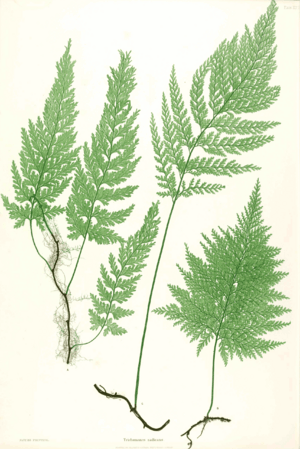Killarney fern facts for kids
Quick facts for kids Killarney fern |
|
|---|---|
 |
|
| Conservation status | |
| Scientific classification | |
| Genus: |
Vandenboschia
|
| Species: |
speciosa
|
| Synonyms | |
|
|
The Killarney fern (scientific name: Vandenboschia speciosa) is a very special type of fern. It is also known by its older name, Trichomanes speciosum. This fern is mostly found in Western Europe.
It grows most often in places like Ireland, the United Kingdom, Brittany (in France), Galicia (in Spain), the Canary Islands, Madeira, and the Azores. You can also find it in other parts of France, Spain, Portugal, and Italy. This fern is a "relict" species. This means it is a leftover from a time long ago when it grew much more widely across Europe. The climate changed a lot during the Tertiary and Quaternary periods, which made its habitat shrink.
Contents
Killarney Fern: A Unique Plant
The Killarney fern has a very unusual life cycle. It spends a lot of its time in a special stage called the gametophyte phase. In this stage, it can reproduce without needing spores. This gametophyte can live in darker and drier places than the main fern plant.
Its Amazing Life Cycle
The main fern plant, which is called the sporophyte, is quite rare. In the UK, you can only find the sporophyte form in about 16 places. However, the gametophyte form is found in more locations. This fern was once thought to be gone from Scotland. This was because many Victorian collectors took them. But luckily, it was found again on the Isle of Skye in its gametophyte form.
Why It Needs Protection
The Killarney fern is considered a vulnerable plant in the UK. It is one of Europe's most threatened plants. It usually grows near the western coasts of the United Kingdom and Ireland. You can also find it in some scattered places inland.
What It Looks Like
The Killarney fern is a medium-sized fern that lives for a long time. It has delicate, see-through leaves that are deeply divided. These leaves grow from a creeping stem called a rhizome. It is one of only three types of ferns in Europe with leaves that you can almost see through.
This fern needs a very humid place that does not get frost. In Britain, it mostly lives in damp, shady, and sheltered spots, like deep valleys. In Ireland, it can grow in more different kinds of places. In Brittany, France, it even grows on the old stone walls of ancient wells.
How It Is Protected
Because it is so rare, the Killarney fern became a protected species in the UK in 1975. This was done under a law called the Conservation of Wild Creatures and Wild Plants Act. This law helps to keep this special fern safe from harm.


